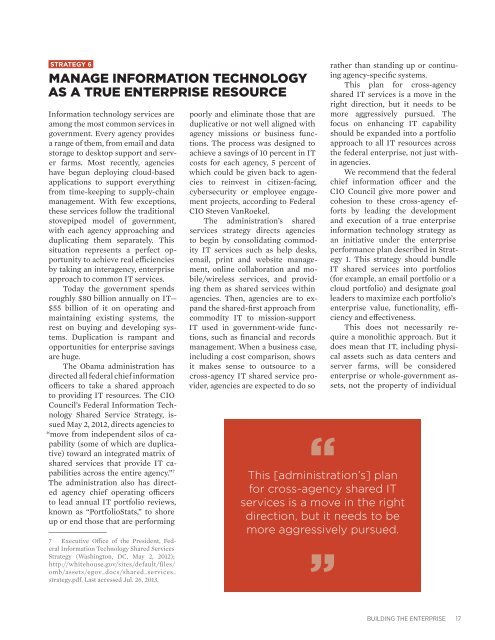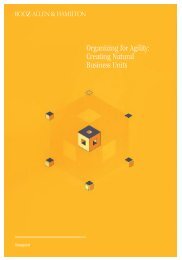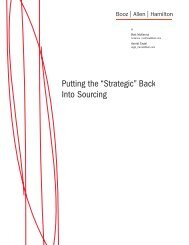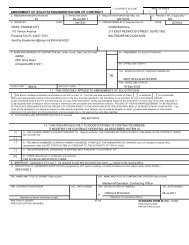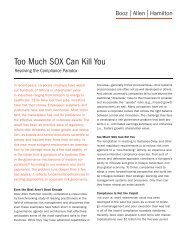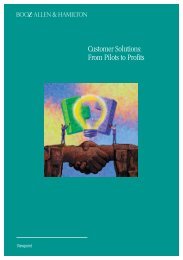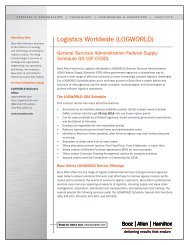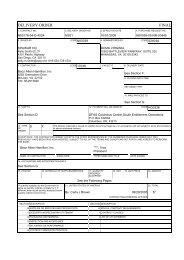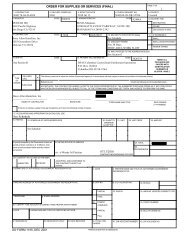Building the Enterprise - Booz Allen Hamilton
Building the Enterprise - Booz Allen Hamilton
Building the Enterprise - Booz Allen Hamilton
- No tags were found...
You also want an ePaper? Increase the reach of your titles
YUMPU automatically turns print PDFs into web optimized ePapers that Google loves.
STRATEGY 6MANAGE INFORMATION TECHNOLOGYAS A TRUE ENTERPRISE RESOURCEInformation technology services areamong <strong>the</strong> most common services ingovernment. Every agency providesa range of <strong>the</strong>m, from email and datastorage to desktop support and serverfarms. Most recently, agencieshave begun deploying cloud-basedapplications to support everythingfrom time-keeping to supply-chainmanagement. With few exceptions,<strong>the</strong>se services follow <strong>the</strong> traditionalstovepiped model of government,with each agency approaching andduplicating <strong>the</strong>m separately. Thissituation represents a perfect opportunityto achieve real efficienciesby taking an interagency, enterpriseapproach to common IT services.Today <strong>the</strong> government spendsroughly $80 billion annually on IT—$55 billion of it on operating andmaintaining existing systems, <strong>the</strong>rest on buying and developing systems.Duplication is rampant andopportunities for enterprise savingsare huge.The Obama administration hasdirected all federal chief informationofficers to take a shared approachto providing IT resources. The CIOCouncil’s Federal Information TechnologyShared Service Strategy, issuedMay 2, 2012, directs agencies to“move from independent silos of capability(some of which are duplicative)toward an integrated matrix ofshared services that provide IT capabilitiesacross <strong>the</strong> entire agency.” 7The administration also has directedagency chief operating officersto lead annual IT portfolio reviews,known as “PortfolioStats,” to shoreup or end those that are performing7 Executive Office of <strong>the</strong> President, FederalInformation Technology Shared ServicesStrategy (Washington, DC, May 2, 2012);http://whitehouse.gov/sites/default/files/omb/assets/egov_docs/shared_services_strategy.pdf. Last accessed Jul. 26, 2013.poorly and eliminate those that areduplicative or not well aligned withagency missions or business functions.The process was designed toachieve a savings of 10 percent in ITcosts for each agency, 5 percent ofwhich could be given back to agenciesto reinvest in citizen-facing,cybersecurity or employee engagementprojects, according to FederalCIO Steven VanRoekel.The administration’s sharedservices strategy directs agenciesto begin by consolidating commodityIT services such as help desks,email, print and website management,online collaboration and mobile/wirelessservices, and providing<strong>the</strong>m as shared services withinagencies. Then, agencies are to expand<strong>the</strong> shared-first approach fromcommodity IT to mission-supportIT used in government-wide functions,such as financial and recordsmanagement. When a business case,including a cost comparison, showsit makes sense to outsource to across-agency IT shared service provider,agencies are expected to do sora<strong>the</strong>r than standing up or continuingagency-specific systems.This plan for cross-agencyshared IT services is a move in <strong>the</strong>right direction, but it needs to bemore aggressively pursued. Thefocus on enhancing IT capabilityshould be expanded into a portfolioapproach to all IT resources across<strong>the</strong> federal enterprise, not just withinagencies.We recommend that <strong>the</strong> federalchief information officer and <strong>the</strong>CIO Council give more power andcohesion to <strong>the</strong>se cross-agency effortsby leading <strong>the</strong> developmentand execution of a true enterpriseinformation technology strategy asan initiative under <strong>the</strong> enterpriseperformance plan described in Strategy1. This strategy should bundleIT shared services into portfolios(for example, an email portfolio or acloud portfolio) and designate goalleaders to maximize each portfolio’senterprise value, functionality, efficiencyand effectiveness.This does not necessarily requirea monolithic approach. But itdoes mean that IT, including physicalassets such as data centers andserver farms, will be consideredenterprise or whole-government assets,not <strong>the</strong> property of individual“This [administration’s] planfor cross-agency shared ITservices is a move in <strong>the</strong> rightdirection, but it needs to bemore aggressively pursued.”BUILDING THE ENTERPRISE 17


